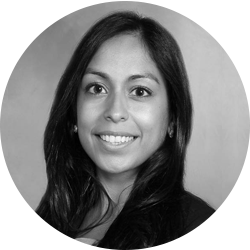supported by


Priyanka Sood, MD
Priyanka Sood, MD,is an Assistant Professor of Ophthalmology at Weill Cornell Medical College in New York, New York.
1. Please share with us your background.
I grew up in Buffalo, New York, with my parents, older sister, and younger brother. Interestingly, both of my siblings are also ophthalmologists; my sister is a glaucoma specialist at the Cleveland Clinic, and my brother is a first-year resident at Emory. We joke that someday we will start our own multispecialty ophthalmology practice and name it Sood3. In our logo, the “oo” would be eyeballs—it would be pretty amazing!
I was part of the 7-year Honors Program in Medical Education at Northwestern University, where I received my bachelor’s degree in environmental science and then went on to medical school in downtown Chicago. After medical school, I moved down to Atlanta, where I completed my transitional year followed by my residency training at Emory University. Finally, I completed my training in cataract, refractive, and cornea surgery at Weill Cornell Medical College in New York City and was fortunate to stay on as a faculty member.
2. What drew you to ophthalmology and, specifically, to your field of interest?
I lived with my sister when I was in medical school and she was in the ophthalmology residency program at University of Illinois, Chicago. Ophthalmology was actually the one specialty that I proclaimed I would NOT pursue in my first year of medical school because I had already pursued medicine like my sister, and I felt that I needed to be different. I considered so many different fields of medicine throughout medical school, but ultimately I realized that the artistic side of my brain was truly stimulated by microsurgery, and the opportunity to improve patients’ quality of life on a daily basis was incredibly satisfying—hence, ophthalmology! Cornea was a natural for me, as I enjoy the technology and the ability to maximize a patient’s visual potential through refractive cataract and corneal procedures.
3. Please describe your current position.
As an Assistant Professor in the Department of Ophthalmology at Weill Cornell Medical College, I work closely with the residents and fellows in clinic and the OR. I also get to be involved in teaching at the medical school, where I facilitate problem-based learning classes for the second-year medical students. My mom recently found a school project of mine from the fifth grade that was a children’s book I wrote and illustrated. In the “About the Author” section, I wrote a few snippets about myself, followed by the statement, “She someday hopes to become an eye doctor or teacher.” Amazing how I managed to achieve both!
4.Who are/were your mentors?
I have been fortunate to have many amazing mentors throughout my career. During residency, I got to work with phenomenal cornea specialists like Brad Randleman, MD, and Doyle Stulting, MD, PhD, who first sparked my interest in pursuing cornea. Geoff Broocker, MD, was also an amazing mentor at Emory, and he will always be that voice in my head when thinking about complicated surgeries or making ethical decisions. I also had good friends who have acted as mentors, including Surendar Dwarakanathan, MD, a cornea specialist and Residency Program Director at Cook County Health System, and my sister, Shalini Sood-Mendiratta, MD. Finally, in fellowship, I was fortunate to work with my current colleagues, who were instrumental in shaping me into the specialist that I am today, including Mark Rosenblatt, MD, PhD; Kimberly Sippel, MD; Christopher Starr, MD; Jessica Ciralsky, MD; and Edward Lai, MD. It’s wonderful to work with the people who trained you!
5.What has been the most memorable experience of your career thus far?
My most memorable experiences have been my international trips to Ghana and Mauritius, where I was able to work on skills and knowledge transfer with local ophthalmologists as well as perform complex corneal transplants in patients with corneal blindness.
6. What are some new technological advances that you have found particularly exciting? Which advances in the pipeline are you most enthusiastic or curious about?
I find the work on presbyopia-correcting treatments to be very exciting! Corneal inlays, scleral implants, and laser procedures are all coming down the pipeline, and as I get closer to presbyopic age, I find my interest piquing. 😉
7. What is the focus of some of your research?
Being fairly early in my career, my research focus is still evolving. I am trying to figure out how to turn my passions for teaching and international work into research. Ultimately, I may decide to pursue the Academic Educator Track that is offered at Cornell. Stay tuned!
8. What is a typical day in your life? What keeps you busy,fulfilled, and passionate?
A typical day for me involves clinic or OR with the residents. I also facilitate problem-based learning classes with the second-year medical students a few days a week. The diversity of my days keeps me interested and motivated. Watching my residents grow and become confident, successful physicians and surgeons is very gratifying.
9. What advice can you offer to individuals who are just now choosing their career paths after finishing residency or fellowship?
Give yourself time to evolve. It can be tempting to feel the need to establish yourself quickly; however, the reality is, your first few years of practice still involve a vast amount of growing and learning. Do not be afraid to fail or try something new, and definitely rely on your mentors and colleagues to help you along the way.
10. Tell us about an innovative procedure you are performing or a new imaging/diagnostic tool that has improved your practice.
I have incorporated some of the newer point-of-care tests that allow us to more objectively assess ocular surface diseases, such as the TearLab Osmolarity System (TearLab) and InflammaDry (Rapid Pathogen Screening). These tools have definitely been game changers for my practice, and I look forward to continuing to assimilate them into my practice patterns.


